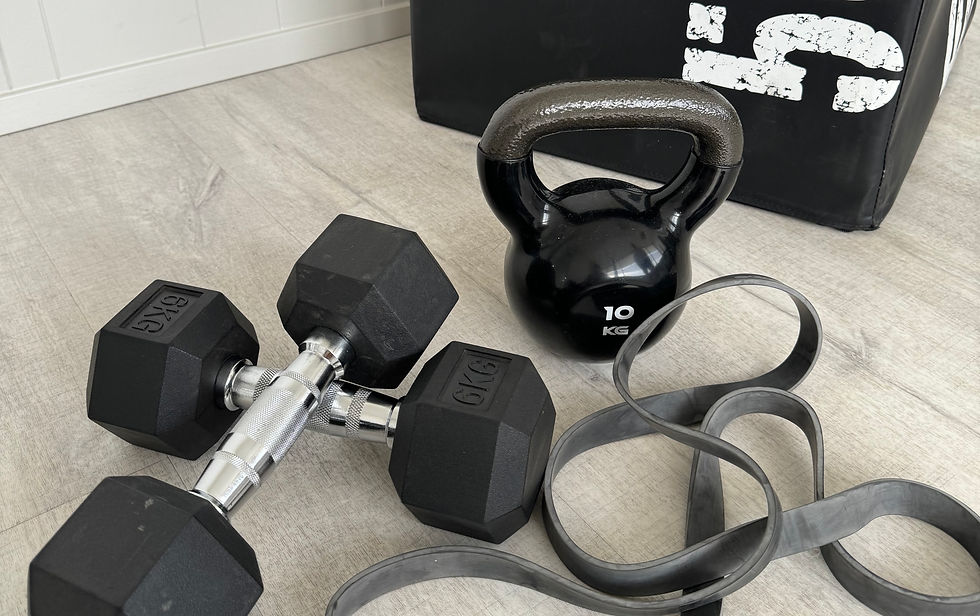Osteoporosis - a silent pandemic
- Sarah Ashe

- Oct 20, 2024
- 4 min read
Osteoporosis is very common, a silent pandemic with an estimated 6.2 million Australians 50 years or older having osteoporosis or osteopenia.
Silent because often there are no symptoms until a fracture is identified.
It is a long-term disease.
Osteoporosis
Bones become less dense, lose minerals like calcium, become more fragile and prone to fractures with falls or min impact.
Osteo means bones. Porosis means porous.
Osteopenia
When bone density is between normal and osteoporotic, low but not at osteoporotic levels
CAUSES
Osteoporosis is caused by a decrease in bone density, making bones more fragile and easier to break.
Everyone’s bones become weaker with age but in some this process happens more quickly.
RISK FACTORS
your age
being female
early menopause (before 45 years)
menopause
having a history of fractures
a family history of hip fractures
some diseases — such as hyperthyroidism, anorexia nervosa, chronic liver and kidney disease, diabetes, HIV, coeliac, rheumatoid arthritis
some medicines — such as cancer treatments, corticosteroids, epilepsy,
smoke or high alcohol intake
low body weight
recurrent falls
low levels physical activity
You can find out more about your risk of developing osteoporosis by using the Know your Bones self-assessment tool. This tool has been developed by the Garvan Institute of Medical Research and Healthy Bones Australia.

DIAGNOSIS
Osteoporosis is diagnosed with your GP using a combination of:
Medical history - particularly reviewing the above risk factors especially fractures, unexplained pain, menopause and family history.
DXA scan – bone mineral density test. The result of your bone density scan is usually presented as a score called a ‘T- score’.
T- score of -1 or above is normal.
T score between -1 and -2.5 means you have lower than normal bone density (osteopenia), and you may develop osteoporosis in the future.
T- score of -2.5 or below means you already have osteoporosis.
Early diagnosis and treatment leads to improved management as you get older.
MANAGEMENT
Life style changes
getting enough vitamin D from the sun
stopping smoking
maintaining a healthy weight — this can mean losing or gaining weight, depending on your BMI
cutting back on alcohol — drink no more than 2 standard drinks a day
exercise — brisk walking, strength and balance training can help your bones become stronger, balance training
Prescription meds
GP or endocrinologist prescribed.

EXERCISE GUIDELINES
3-4 exercise sessions/wk incorporating:
Weight Bearing Impact Loading Exercises
Work against gravity to stimulate bone. It is through the weight of the body on the bones that the bones become stronger over time.
Resistance Training
Moves that emphasis to power and balance using added weights to enhance strength and stability.
Balance Training
Exercises that strengthen the muscles that keep you upright such as your legs and core which helps to improve stability and decrease falls risk.
Postural Alignment
Posture will impact movement efficiency, muscle activation and where the load is spread.
Functional Training
Incorporating the above into regular daily movement patterns with impact your incidental exercise positively and increase your capacity to enjoy life.
IS WALKING ENOUGH?
Walking is good but not a sufficient exercise regime to manage osteoporosis if it is the only form of exercise.
It only influences the legs and spine.
Speak to your physio re adding extra load and impact to your walking by simply using light weights and pace.
IS SWIMMING A GOOD EXERCISE TO MANAGE OSTEOPOROSIS?
No swimming is a non-weight bearing exercise so not beneficial for managing osteoporosis.
It is good for other reasons though – cardio vascular fitness, non-weight bearing strength and managing injury, including stress fractures.
IS PILATES GOOD FOR OSTEOPOROSIS?
Yes, if it incorporates resistance, impact, thoracic extension, weight bearing, standing and balance components. It is also a great way to ensure you have movement competency/capacity before you add significant load.
As you improve load will need to be gradually increased and this is usually done more in a circuit style class or gym environment.
WHAT EXERCISES TO AVOID IF YOU HAVE OSTEOPOROSIS
Abdominal crunches
Full standing rolldown
Toe touches
Spine combined flexion and rotation
High impact rotational sports (eg. golf and tennis)
Bowling
HOW CAN I GET A EXERCISE PROGRAME THAT INCORPORATES ALL THE REQUIRED COMPONENTS AND THAT I ENJOY?
Speak to your physio about your current exercise routine/or lack of and work out what is missing and the various options you need to add.
It may be a combination of the following:
Walking with additional load/pace
Running
Circuit Classes
Bones and Balance classes
Tailored home exercise programme specific to you to manage osteoporosis and other concerns
Tailored gym exercise programme specific to you to manage osteoporosis and other concerns
Supervised, specific physio exercise programme specific to you to manage osteoporosis and other concerns.
Being educated by your physio as to what exercises are contraindicated/high risk with osteoporosis.
Being educated by your physio how to lift and modify daily tasks
Working collaboratively with your GP and physio will lead to best outcomes.
Know that by managing osteoporosis reactively OR proactively means you are also incorporating movement that assists the management of osteoarthritis and other medical conditions. You are likely to feel stronger, healthier, happier and more engaged in your life and community.
Book a free chat or appointment with us to work out what movement would be most beneficial for you.
References
Research Update – Osteoporosis Exercise, Fletcher Conference 2023
Polestar Pilates Australia Osteoporosis Guidelines




コメント